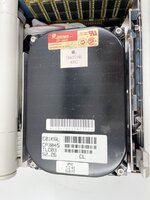The
lead-acid battery on the non-backlit Portable offered up to ten hours of usage time, and the Portable draws the same amount of power when turned off, and when in sleep mode.
[2] Unlike later
portable computers from Apple and other manufacturers, the battery is wired in-series with the AC power supply. There being no possible alternative direct connection to the AC supply, a dead battery meant that the computer could not be operated. The original power supply had very low output.
Several popular unauthorized workarounds were devised, including using a power supply from the PowerBook 100 series, which provides higher output. As with automotive batteries, the sealed lead-acid cells used in the Portable failed if they were fully discharged. The batteries are no longer manufactured and it is very rare to find an original battery that will hold a charge and allow the computer to start. It is possible to repack the battery with new cells, or use alternative 6 V batteries.
[3] There were three lead-acid cells inside the battery: each were manufactured by Gates Energy Products (now EnerSys), and they were also used in Quantum 1 battery packs for photographic flash use.[
citation needed]

